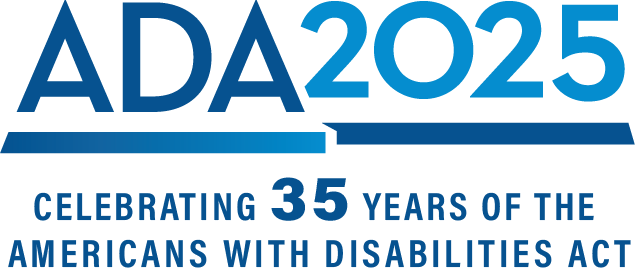- Home
- ADA
Celebrating the Americans with Disabilities Act
On July 26, 1990, the Americans with Disabilities Act (ADA) was signed into law. This landmark civil rights law affirmed the inherent dignity of every person, regardless of disability. This sweeping legislation prohibits discrimination by local and state governments, provides standards for privately owned businesses and commercial facilities, protects people with disabilities from discrimination in the workplace, and ensures equal access to health care, social services, transportation, and telecommunications. Since its enactment, our country has taken great strides toward the ADA's promise of true inclusion. Americans with and without disabilities increasingly live, learn, work, play, and contribute side by side.
The U.S. Department of Health and Human Services’ (HHS’) Administration for Community Living (ACL) and Office for Civil Rights (OCR) work closely together to defend the rights of people with disabilities and ensure equal access to all facets of life. This website celebrates the ADA by telling the story of how it became law, showcasing some of the progress we have made as a country toward achieving its promise, and, most importantly, highlighting the impact of the ADA according to people with disabilities. See ACL’s About Community Living for information on how ACL improves the lives of people with disabilities through services, research, and education; and OCR’s Community Living and Olmstead for more information on OCR’s enforcement of the ADA and other relevant laws.

In Their Own Words: The History of the ADA
The ADA is the culmination of many years of determined effort by people with disabilities and other disability advocates. It came to life with the support of many in Congress and across the George H.W. Bush administration. Through recent interviews and historical footage, some of those key figures narrate the events and milestones that led to the ADA’s creation and passage.
Origins of the ADA
By the mid-1980s, the consensus was that additional legislation was needed to uphold the civil rights of people with disabilities. Here’s how it got started.
Crafting the Law
Moving from consensus about the general need to drafting a law everyone could support took patience, perseverance, and a lot of pounding the pavement.
The ADA Becomes Law
Getting the bill through Congress took 11 hearings and two conferences over nine months, and last-minute negotiations over contentious issues threatened its survival.

Achieving the Promise: Inclusion and Integration in America
With a national expectation of accessibility and full participation clearly established by the ADA, we have seen an explosion of tools and technology to assist people with a wide range of disabilities; advances in the accessibility of health care and greater recognition of the equal rights of people with disabilities to receive both life-saving and routine care; and schools, workplaces, and recreational activities that are more inclusive than ever before.
Tools and Tech
We all use tools to make our lives easier, and advancements in technology have given all of us the ability to do things we could not do on our own. For many people with disabilities, tools and technology are rapidly expanding opportunities for inclusion and independence.
Health Care
People with disabilities often face barriers to accessing health care. Inaccessible facilities and equipment can physically prevent access, inaccurate assumptions can lead doctors to offer fewer or less aggressive options, and in extreme — but not rare — cases, people are denied care because of their disabilities.
Learn, Work, and Play
Communities are strongest when everyone can contribute, and everyone benefits when everyone is included. Across the United States, communities are changing to be more inclusive of people with disabilities — in schools, workplaces, sports and other recreational activities, the arts, and more.
ADA: A Timeline

 Extended description of the ADA Timeline is provided here. 1986 was the NCD move toward independence; in 1988 the ADA was introduced at the 100th Congress; in 1990 The Americans with Disabilities Act (ADA) was passed; in 1999 the Supreme Court passed the Olmstead Act; in 2008 the ADA Amendments Act (ADAAA) was signed; in 2014 the U.S. Access Board Guidelines went into effect; in 2015 the ADA celebrated 25 years; and in 2020 the ADA is celebrating its 30th year.
Extended description of the ADA Timeline is provided here. 1986 was the NCD move toward independence; in 1988 the ADA was introduced at the 100th Congress; in 1990 The Americans with Disabilities Act (ADA) was passed; in 1999 the Supreme Court passed the Olmstead Act; in 2008 the ADA Amendments Act (ADAAA) was signed; in 2014 the U.S. Access Board Guidelines went into effect; in 2015 the ADA celebrated 25 years; and in 2020 the ADA is celebrating its 30th year.Last modified on 07/14/2025


